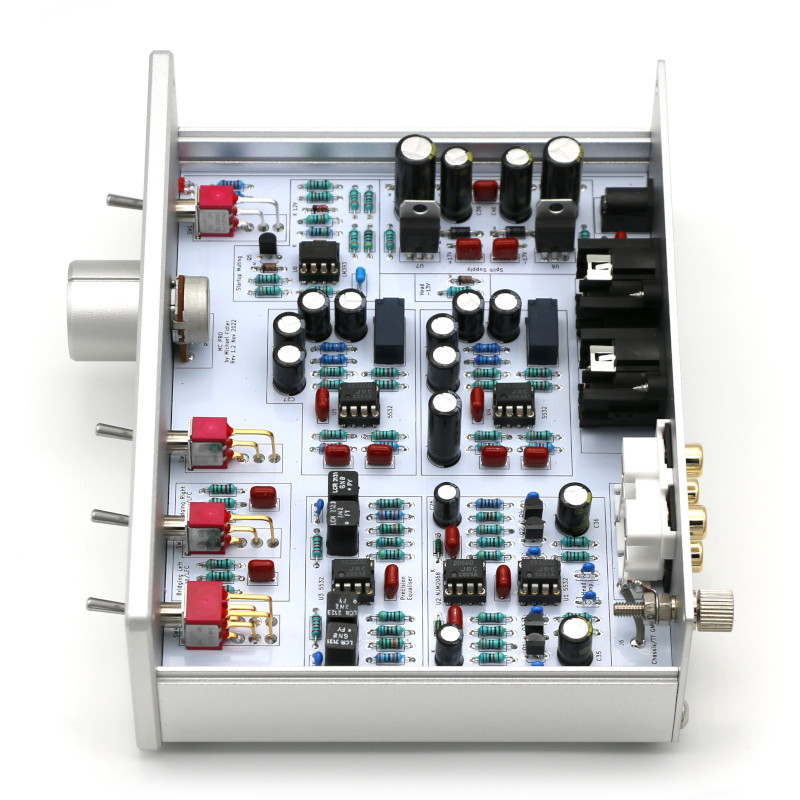This is a review and measurements of the Classic Audio MC Pro by Michael Fidler. It was sent to me by the company and costs US $850 (£650/€750).

As non-fancy enclosures go, this is pretty nice looking and with some unusual features such as low frequency blending to reduce noise, mono switch and selectable gain. Back panel shows another unusual feature: balanced XLR out:

I like balanced output as audio gear has its only ground loops which we don't want to add the heap that phono stage may bring. As such, all of my testing was done using that output.
Check out how beautiful the insides look:

There should be a transparent top as an option for folks to enjoy looking at it!
Tested gain setting was 63.
Classic Audio MC Pro Measurements
Let's start with our usual dashboard of 0.5 mv input:

Notice the total absence of distortion as it should be. I don't have a ranking table to show you for SINAD but typical values are in 60 dB range so this is quite good.
Company advertise hyper accurate RIAA equalization which I was able to verify:

Our overload test shows more headroom than I am used to see with moving coil phono preamps:

Stepping through different frequencies we see remarkable ability to keep distortion at bay regardless of what it is:

Measuring distortion by itself naturally shows excellent response:

Conclusions
The MC Pro is a very accurate phono stage with very low noise and distortion. Company has full set of specifications which means great attention was paid to these factors. I like the unique design with extra features and of course, XLR balanced output. The cost is up there for a non-high-end phono stage but I think it is justified given the performance and features.
It is my pleasure to add the Classic Audio Michael Fidler MC Pro phonostage to my recommended list.
Manufacturer Specifications:
----------
As always, questions, comments, recommendations, etc. are welcome. Click here if you have some audio gear you want me to test.
Any donations are much appreciated using: https://www.audiosciencereview.com/forum/index.php?threads/how-to-support-audio-science-review.8150/
As non-fancy enclosures go, this is pretty nice looking and with some unusual features such as low frequency blending to reduce noise, mono switch and selectable gain. Back panel shows another unusual feature: balanced XLR out:
I like balanced output as audio gear has its only ground loops which we don't want to add the heap that phono stage may bring. As such, all of my testing was done using that output.
Check out how beautiful the insides look:

There should be a transparent top as an option for folks to enjoy looking at it!
Tested gain setting was 63.
Classic Audio MC Pro Measurements
Let's start with our usual dashboard of 0.5 mv input:
Notice the total absence of distortion as it should be. I don't have a ranking table to show you for SINAD but typical values are in 60 dB range so this is quite good.
Company advertise hyper accurate RIAA equalization which I was able to verify:
Our overload test shows more headroom than I am used to see with moving coil phono preamps:
Stepping through different frequencies we see remarkable ability to keep distortion at bay regardless of what it is:
Measuring distortion by itself naturally shows excellent response:
Conclusions
The MC Pro is a very accurate phono stage with very low noise and distortion. Company has full set of specifications which means great attention was paid to these factors. I like the unique design with extra features and of course, XLR balanced output. The cost is up there for a non-high-end phono stage but I think it is justified given the performance and features.
It is my pleasure to add the Classic Audio Michael Fidler MC Pro phonostage to my recommended list.
Manufacturer Specifications:
| Parameter | Measurement |
|---|---|
| RIAA Accuracy | ±0.1dB, 40Hz to 22kHz |
| Channel balance | ±0.1dB, 40Hz to 22kHz |
| Signal to noise ratio (220Hz to 22kHz) | 81.5dB, ref 500µV, 10Ω cartridge |
| Total harmonic distortion | <0.0005%, 20Hz to 22kHz, at 21V RMS |
| Maximum output (20Hz to 28kHz) | 21V RMS (XLR), or 10.5V RMS (RCA) |
| Maximum input at 1kHz | 7.3mV RMS at 63dB gain, 2.3mV RMS at 73dB gain |
| Maximum input at 10kHz | 35mV RMS at 63dB gain, 11.3mV RMS at 73dB gain |
| Overload margin, ref 500µV, at 1kHz | 23.3dB at 63dB gain |
| Overload margin, ref 150µV at 1kHz | 23.8dB at 73dB gain |
| Gain at 1kHz (RCA) | 63.17dB, 1440x, or 73.1dB, 4520x |
| Gain at 1kHz (XLR) | 69.19dB, 2880x, or 79.12dB, 9040x |
| Minimum load impedance | 1kΩ (RCA), 2kΩ (XLR) |
| Output impedance | 75Ω (RCA), 150Ω (XLR) |
| Input impedance | 120Ω |
| Subsonic filter | 23Hz, 3rd order, for -23dB at 10Hz |
| Low frequency crossfeed | 65Hz to 600Hz, -4.3dB to -21.6dB at 50Hz |
| Dimensions (W*H*D) | 172*60*155mm |
| Power consumption | 6W max powered on, 0.2W standb |
As always, questions, comments, recommendations, etc. are welcome. Click here if you have some audio gear you want me to test.
Any donations are much appreciated using: https://www.audiosciencereview.com/forum/index.php?threads/how-to-support-audio-science-review.8150/
Last edited:
